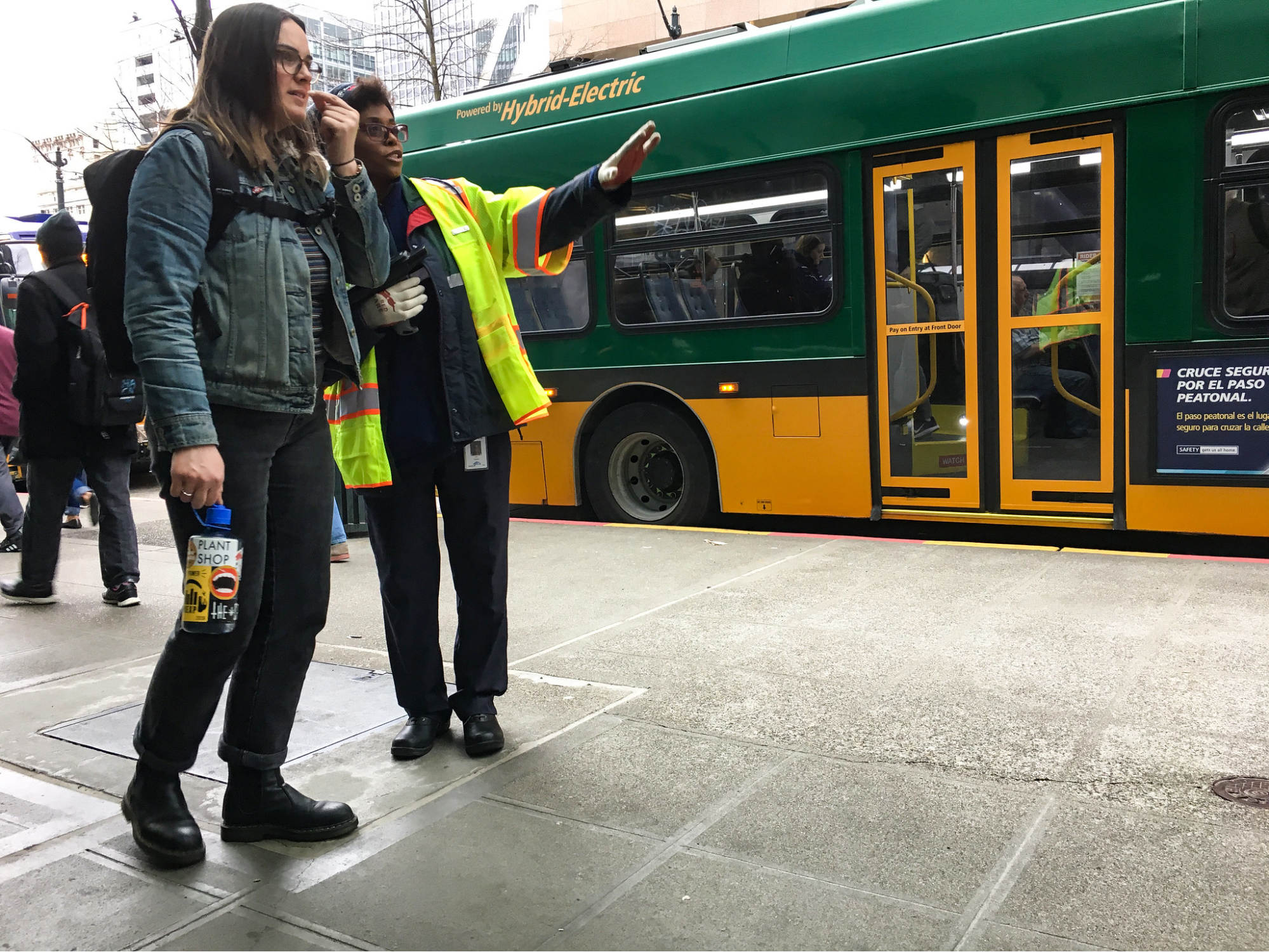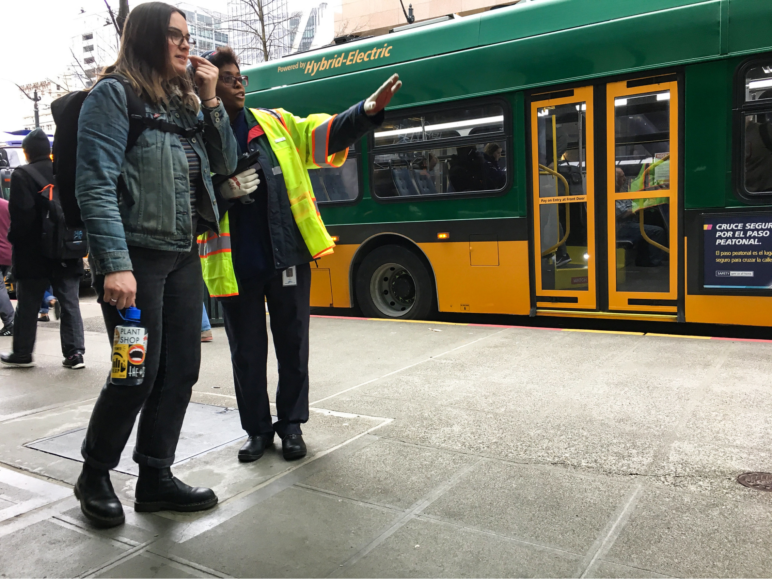Chalk this one up for the public transit heroes.
The King County Council voted 5-3 Wednesday to let riders of its Metro bus system pay for their parking with money, rather than time, if they want to.
At 10 of the system’s most crowded park-and-ride lots, Metro will soon sell monthly permits to access up to half the parking spaces that adjoin major bus hubs.
Carpoolers will still be able to get free permits, and low-income riders will get steep permit discounts.
It’s a fairly modest policy shift—projected net revenue is just $640,000 per year by 2021, less than a tenth of one percent of the agency’s operating budget—but a symbolically crucial one. That’s because free park-and-rides, when they’re built, are seriously expensive and one of the worst possible ways to use the precious land near high-service transit hubs.
By King County Metro’s calculations, bus lanes and signals boost ridership three times more per dollar and benefit all riders, not only the disproportionately wealthier and whiter ones who can afford cars.
Despite that, agencies across the Pacific Northwest and beyond have kept building free park-and-rides due to a combination of false economy, perverse federal incentives and politicians who don’t ride or understand transit themselves. As I wrote last week, it’s a series of honest mistakes that add up to the work you’d expect from a devious anti-transit supervillain.
For frustrated transit riders, the effect is more like a hot dog stand that always runs out of hot dogs by 7 a.m., because it insists on giving them all away for free to whoever is able to show up first.
At King County Metro, one of the nation’s most respected and successful transit agencies, no more. The change was led by Councilmember Claudia Balducci, the former mayor of Bellevue, who cited Donald Shoup’s groundbreaking book The High Cost of Free Parking from the dais.
Metro will join British Columbia’s Translink—by far the most-ridden transit agency in Cascadia—in charging for parking at the busiest lots. (Sound Transit, the agency that operates Seattle-region passenger rail, also started charging for some parking spaces last year.)
If Metro is smart, it’ll reinvest the net revenue in things that reduce the need for anyone to park near the stations: bus signals, all-ages bike networks, crosswalks.
TriMet, in the Portland metro area, continues to offer free park-and-rides. This summer, a steering committee is considering whether to spend tens of millions on more free parking spaces as part of a new rail project that could go before voters next year.
Charging for parking isn’t a one-stop solution to transportation problems, of course. But we’ve been focusing on it here at Sightline for decades now because the problems of parking “shortages” are similar everywhere, and supremely solvable. The answer isn’t to pour hundreds of millions into more and more free parking. It’s to require parking to pay its way like everything else that can happen on the land next to a really good transit stop.
Once you’ve done that, it becomes easy to see that “everything else” creates more value, and in the long run delivers far more riders, than seas of asphalt and concrete. There are many better ways to spend precious public-transit resources than on subsidizing driving with free parking.
King County Metro will soon start proving that, just like every other transit agency that’s gone before it.










Bebe Kirkwood
Park and Ride transit centers are NOT FREE. The people using them paid for them with their TAXES!
Michael Andersen
Same is true of any public service. The question here is which public services should be more subsidized and which should be less subsidized.
Karen
For the price they want to charge I might as well drive to work and pay the parking garage fees.
Michael Andersen
One nice thing about the policy is that if more than a few spaces are going empty, they will lower the price to ensure that they fill up.
mh
Those people NOT using them also paid through their taxes. If residents have to pay for basics that everyone needs and uses, like water, why should users of an even more expensive and less critical amenity like a parking space have it at no additional cost?
Bill Popp
I was part of the team at PSCOG that enabled creation of the 4 county transit agencies with their supporting park and ride lots along with the freeway HOV lane system. The voter approved sales tax packages included free park and ride lots and some were constructed by WSDOT using gas tax funds — also intended to be free! At that time the prime directive was to maximize transit and car pool/van pool usage, but apparently that is no longer top priority as this latest move is a backward step in terms of facilitating multi-modal use of our highway system. For the amount of tax money directed at transit service in this region (60% of all transportation tax $), most of which is poorly utilized outside of Seattle (empty buses), there is no excuse for penalizing use of the most continuously successful part of the program we created some 40 yrs ago. What is really needed is a major commitment to build more of what the traveling public needs and will utilize — this latest move fits in the realm of shooting oneself in the foot. Ask Microsoft, Google, Amazon, T-Mobil, Boeing what they think about penalizing park and ride users. Not all transit or car/vanpooling originates with the transit agencies — a significant portion of it is private and the park and ride lots play an important role in making this happen.
Michael Andersen
Buses running nearly or completely empty in the lower-density suburbs are providing lifeline mobility for seniors, teens and extremely poor people. But it’s true that empty buses are expensive. If we want to prevent empty buses, we can either:
– axe off-peak suburban service and leave those people stranded, or
– densify land uses near suburban transit stops; add bus signals and queue jumps that make transit travel times more competitive with private cars; and add more frequency to existing bus lines so people can count on them instead of needing to memorize their schedules. Park and rides physically interfere with the first of those three options, and not charging for overcrowded park-and-rides means forgoing revenue that can be used for the other two.
Karen F
As a rider, I agree! Adding more expense to taking the bus instead of driving seems counter-productive. Where I live, there’s no public transportation to get to the Park & Ride!! So if I can’t drive there, I’d have to take a cab or rideshare just so I can take the bus. This is the situation for most using public transit. There’s not a bus every 2 blocks in my area to take me to work or to park & ride. And if you have a problem walking far like me (from arthritis), you’re really screwed!!! And many riders aren’t making big bucks. I work at a store downtown so am in the lower income bracket. My car is a 1998, so obviously all car-owners are not well-off. At 63, with the arthritis, I’m lucky to have a job with medical and there aren’t any jobs I’m qualified for or wanted for in my area.
Rent went up another $50 month so my income now just gets me by & I’m scared everyday I’ll end up homeless. So city council needs to realize that they’re dealing with real people whose lives don’t fit into 1 mold. Just because a person owns a car doesn’t mean they have a great income, and parking costs will drastically affect lives.
Michael Andersen
Definitely it is true that many car owners are not well off. But the reason there is no bus in your area, of course, is that running buses costs money. Seems to me that the question is how to spend limited resources.
Mathematically, it turns out that we can serve more people and help more low-income people with bus service, bus lanes/signals, and fare discounts than by building parking lots and making them free in the hopes that a few of the people who are able to show up early enough to use them might be low-income.
That said, note that low-income riders will pay less than $1/day for passes, and can also show up early to use the half of spaces that will remain first come, first served.
Sloopy
I agree with you Michael but your flippant attitude towards commenters with concerns is a turn off. There are many people who don’t have good access to transit and don’t have the money to live centrally and they deserve to be able to explain their situations without being talked down to.
Also, why are we encouraging driving for the poor by making it cheaper based on income? Wouldn’t that money be better deployed for more transit service? I mean, they can take the bus to the park and ride too, right? Inconsistent logic.
Michael Andersen
That’s a fair criticism, and Karen, I apologize. Sloopy is right: my answer to you was definitely too flippant. Rising home prices are a huge problem, especially for people on the margin of losing their homes. My reply minimized that with greater-good mumbo-jumbo. It shouldn’t have.
I continue to believe, however, that making park-and-rides free is a terrible way to spend public money. There are so many better ways for a transit system to spend it, including improving bus travel (through signal-related speed improvements or more service hours in more places) and lowering bus fares. Either of these options would help riders like you as well as the many thousands of King County residents who are also struggling but don’t use park-and-rides at all.
BK
It seems clear that permits can be discounted based on income (for example, in Seattle Residential Parking Zone (RPZ) permits are $65/year, but if you’re income-qualified they’re $10. It seems like one option might be to structure license to park as a permit, in which case you could set a general rate and then make the discounted rate, for whatever is defined as low income, much, much less (heck, $0.01, essentially free).
Alison Wiley | Electrifying Transit
Great article, Michael. I think the discounted parking for low-income riders is crucial. I respect your apology to Karen.
I suspect the reason TriMet is dragging its feet on paid park and rides is the same reason it’s dragged its feet on starting to electrify: unlike the other two major transit systems of Cascadia, it isn’t governed by or accountable to the community in which it operates, but rather, it has a board appointed by the Governor. So, TriMet often is out of sync with the values of Portland.